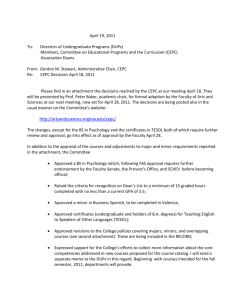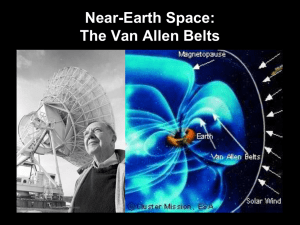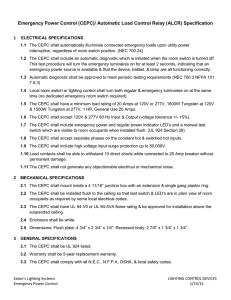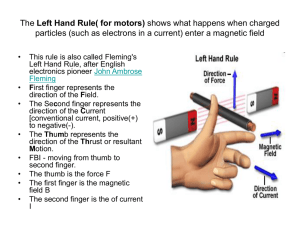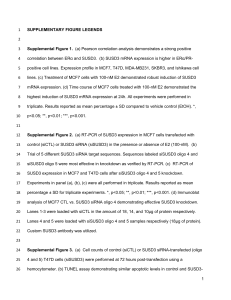Isolating highly enriched populations of circulating
advertisement
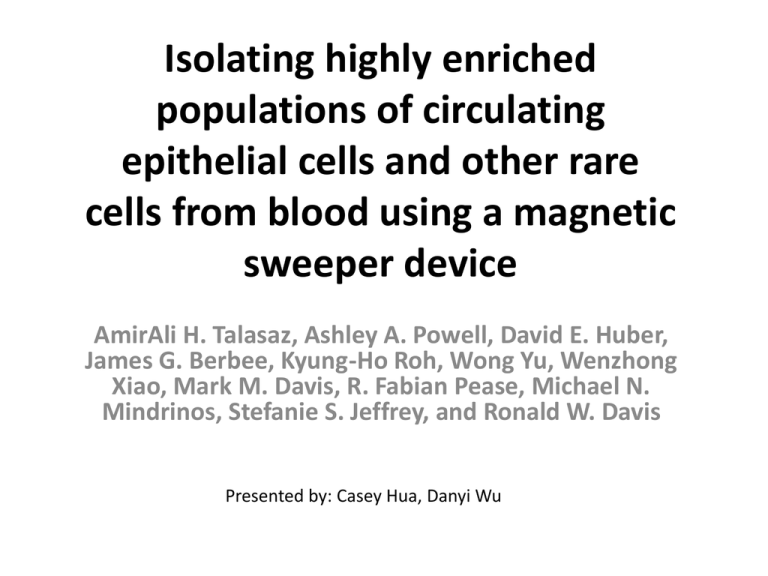
Isolating highly enriched populations of circulating epithelial cells and other rare cells from blood using a magnetic sweeper device AmirAli H. Talasaz, Ashley A. Powell, David E. Huber, James G. Berbee, Kyung-Ho Roh, Wong Yu, Wenzhong Xiao, Mark M. Davis, R. Fabian Pease, Michael N. Mindrinos, Stefanie S. Jeffrey, and Ronald W. Davis Presented by: Casey Hua, Danyi Wu Motivation • Molecular Profiling Applications • Improvement of: • Cancer prognosis/treatment rare circulating epithelial cells (CEpCs) • Immune monitoring antigen-specific lymphocytes • Prenatal diagnosis fetal cells Motivation Problem: Current CEpC isolation platforms lack purification efficiency Solution: MagSweeper –High capture rate –High purity –Enriches target cells (108x) MagSweeper Process 1. Pre-label diluted blood samples with magnetic particles 2. 3. 4. 5. Repeat to eliminate background cells improves purity at some cost to capture efficiency MagSweeper Simulation Magnetic flux density Magnetic forcedriven cell velocity field Cell capture boundary MagSweeper Simulation cont’d Fluid velocity/motion Cell trapping profiles Gap of uncaptured particles due to fluid motion pushing particles ahead of magnet MagSweeper Performance • Enrichment Studies 1. Rare Immunological Model Cells from a Mixed Sample (HLAA2) • • 2. MCF7 Cancer Cells Spiked in Blood Samples • 3. Performance: isolating Circulating Epithelial Cells (CEpCs) CEpCs from Breast Cancer Patients • • Capture Efficiency Purity Application: CEpC isolation from Epithelial Cancers patients Perturbation of Cellular Gene Expression (1) Rare HLA-A2+ cells in Mixed Samples Enrichment by ~2.5x105 (2) MCF7 Cancer Cells Spiked in Blood Samples Combining MagSweeper enrichment with visual inspection and extraction of cells based on size: •increase cell purification of the MCF7 cells from 51% to 100% purity •similar cell capture rates from 62%± 7% of 59%± 27% MCF7 cells isolated by MagSweeper with brightfield and fluorescence imaging. (3) CEpCs in Breast Cancer Patients •Found CEpCs in 47 of 47 samples from patients with metastatic disease •12±23 CEpCs per 9mL blood sample MagSweeper isolation protocol does not perturb gene expression minimal changes in cell profiles: 94% of probe sets have changes <50% Fig. S2. Fold changes in logarithmic scale between the gene expression levels of cultured cells before and after MagSweeper protocol. Advantages of MagSweeper • High enrichment • No prior processing of blood required • Flexibility in starting sample volume & process scalability • Further Optimization: – Extension of the sweep to capture remaining particles in gap left by fluid motion – Refine magnet shape to yield more uniform magnetic field gradient Significance • Diagnose malignancy from blood – Improved cancer prognosis: CEpC numbers correlate better with cancer progression than imaging, lymph node biopsy, and serum biomarker analysis • Enrich CEpCs for molecular analysis – Identify surrogate endpoints for evaluation in clinical trials • Extract individual CEpCs • characterization of single cells for subpopulation studies on heterogenous CEpCs
